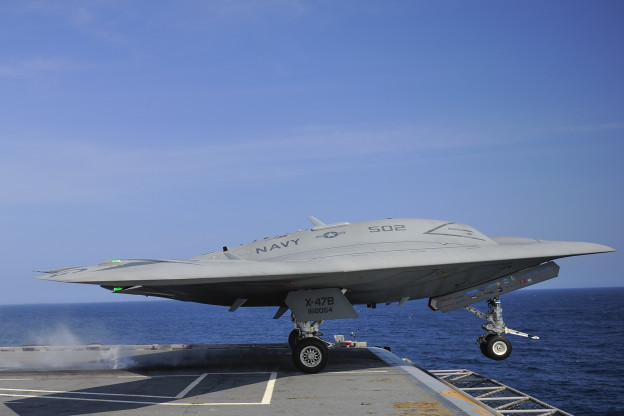
The reduction in strike capability of the Navy’s next generation carrier-based unmanned aerial vehicle was born of fiscal realities, said Dyke Weatherington, the Pentagon’s director of unmanned warfare and intelligence, surveillance, and reconnaissance (ISR), at the Association for Unmanned Vehicle Systems International Unmanned Systems 2013 conference in Washington, D.C., on Tuesday.
Initial requirements for the aircraft indicated a more robust strike capability, but a set of revised parameters paint the picture of a platform that places more emphasis on providing a carrier strike group (CSG) with aerial ISR after the air wing stops operations.
“I believe what happened with UCLASS was a refinement and clarity of that program that affords us what we really have to have at a value that [the Department of Defense]—and specifically the Navy—are willing to invest in to get to that capability level,” Weatherington said. “What resulted were the most critical needs that the Navy had with a plan to grow that ability as much as we could.”
In June, USNI News reported key performance parameters (KPPs) of planned UCLASS that presented a broad outline of the requirements as part of the carrier air wing.
The KPPs called for an aircraft that had a ordnance payload capability of 1,000 pounds, less than quarter of the 4,500-pound ordinance capacity of the two Northrop Grumman X-47Bs used as part of the service’s Unmanned Combat Air System demonstrator (UCAS-D) program.
The unit cost for the aircrafts, less research and development, and operations and maintenance cost (known as recurring flyaway cost), “required to conduct a 600 nautical mile persistent orbit shall not exceed $150 million,” the UCLASS KPPs said.
Weatherington’s statements follow an Aug. 9 report from Flight Global that said the head of the Pentagon’s Joint Requirements Oversight Council (JROC)—Vice Chairman of the Joint Chiefs of Staff Adm. James “Sandy” Winnefeld—had “diluted” the specifications for the platform from an initial capabilities document prepared by the Navy.
The Flight report quoted retired Chief of Naval Operations Adm. Gary Roughead who said, the Navy’s “concept was to evolve the Northrop Grumman X-47B UCAS-demonstrator aircraft into an operational machine. The whole intent was to take that form, pursue refuelability—you get long endurance—and then use that and move forward on that,” Roughead said. “Do it as an evolutionary process.”
Capt. Chris Corgnati—branch head for the unmanned aerial systems requirements and resources in the Office of the Chief of Naval Operations, also on the Tuesday panel—said the Office of the Secretary of Defense’s JROC office ultimately pared down the requirements for the platform.
“We got JROC direction of where the joint force needed to focus,” Corgnati said.
“The service makes their decision, it goes through the joint process to the JROC and the JROC goes through the DOD portfolio: high-end, low-end, what’s the right mix of systems, where do we have gaps, and where do we want to focus a particular programs.” The Navy has not revealed the initial capabilities the service originally crafted for UCLASS but a March story from Inside the Pentagon reported the service was told by JROC to develop a system that would focus more on the surveillance and less on strike.
“The numbers of available orbits provided as a fielded capability within total program budget is the Number One priority for UCLASS,” Winnefeld wrote in a 19 December memo, Inside the Pentagon reported.
Previously, there was a greater emphasis on the strike in a so-called “sprint-to-weapons delivery,” approach for UCLASS.
Weatherington defended the JROC decision saying DOD “can’t afford to start programs that we can’t finish. We can’t afford to start programs that we get two or three into and we have to cancel and we have nothing to show for it.”
According to the Inside the Pentagon report, JROC wanted enough UCLASS for at least one carrier air wing, “within total program budget within three to six years.”
The Navy estimates it could spend up to $2.3 billion on UCLASS between 2013 and 2017.
Both Weaterhington and Corgnati agreed the revised program was in the Pentagon’s and the Navy’s best interests. “I don’t look at it as a lessening of requirements,” Corgnati said. “It was an open and honest debate throughout the building.”
The Navy plans to issue a draft request for proposal for the program in September.
This post was updated to include a revised date for the UCLASS draft request for proposal.





